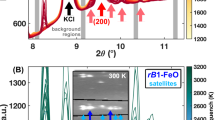Abstract
Orthorhombic zoisite, Ca2Al3Si3O12OH, and its monoclinic polymorph, clinozoisite, are key indicator minerals in low- and middle-grade basic and calcareous metamorphic rocks, and often occur together in apparent equilibrium1. Both minerals contain variable amounts of Fe3+ replacing Al, but clinozoisite always contains more Fe3+, with as much as 30–40% substitution in typical epidote. Interpretations of their relative stabilities, based on field relations1–3 and experimental studies4,5, have conflicted markedly. No unambiguous experimental demonstrations of reversibility of a zoisite–clinozoisite equilibrium have yet been performed, and it may well be that such an equilibrium relation, if it exists, lies in a portion of the P, T plane which is inaccessible to direct investigation. We present here experimental reversals of the Fe-free equilibrium: 2Ca2Al3Si3O12OH + Al2SiO5 + SiO2 = 4CaAl2Si2O8 + H2O (1) zoisite or clinozoisite kyanite quartz anorthite using both clinozoisite and zoisite. At 550 °C, the reaction with zoisite is in equilibirum at 6.30±0.25 kbar and the reaction with clinozoisite is in equilibrium at 7.30±0.15 kbar. Therefore, clinozoisite is considerably less stable than zoisite at this temperature, and the reaction with clinozoisite, though reversible, is metastable. Reliable thermodynamic data for the phases show, with the present experimental data, that zoisite has lower Gibbs free energy at 550 °C by 1,020±400 cal mol−1. Published composition data of natural coexisting zoisite and clinozoisite, together with first-order assumptions as to the equilibrium temperatures of the parageneses, suggest that zoisite entropy is ∼2.5 cal mol−1 K−1 higher than that of clinozoisite and that Fe-free clinozoisite becomes stable relative to zoisite below about 200 °C.
This is a preview of subscription content, access via your institution
Access options
Subscribe to this journal
Receive 51 print issues and online access
$199.00 per year
only $3.90 per issue
Buy this article
- Purchase on Springer Link
- Instant access to full article PDF
Prices may be subject to local taxes which are calculated during checkout
Similar content being viewed by others
References
Enami, M. & Banno, S. Miner. Mag. 43, 1005–1013 (1980).
Tanner, P. W. G. J. Petrol 17, 100–134 (1976).
Ackermand, D. & Raase, P. Contr. Miner. Petrol. 42, 333–341 (1973).
Holdaway, M. J. Contr. Miner. Petrol. 37, 307–340 (1972).
Strens, R. G. J. Miner. Mag. 35, 464–475 (1965).
Seki, Y. Am. Miner. 44, 720–730 (1959).
Goldsmith, J. R. Am. Miner. 66, 1183–1188 (1981).
Robie, R. A., Hemingway, B. S. & Fisher, J. R. Bull. U.S. geol. Surv. 1452 (1978).
Langer, K. & Lattard, D. Am. Miner. 65, 779–783 (1980).
Burnham, C. W., Holloway, J. R. & Davis, N. F. Geol. Soc. Am. Spec. Pap. 132 (1969).
Perkins, D., Westrum, E. F. & Essene, E. J. Geochim. cosmochim. Acta. 44, 61–84 (1980).
Dollase, W. A. Am. Miner. 56, 447–464 (1971).
Author information
Authors and Affiliations
Rights and permissions
About this article
Cite this article
Jenkins, D., Newton, R. & Goldsmith, J. Fe-free clinozoisite stability relative to zoisite. Nature 304, 622–623 (1983). https://doi.org/10.1038/304622a0
Received:
Accepted:
Issue Date:
DOI: https://doi.org/10.1038/304622a0
Comments
By submitting a comment you agree to abide by our Terms and Community Guidelines. If you find something abusive or that does not comply with our terms or guidelines please flag it as inappropriate.



